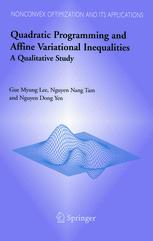

Most ebook files are in PDF format, so you can easily read them using various software such as Foxit Reader or directly on the Google Chrome browser.
Some ebook files are released by publishers in other formats such as .awz, .mobi, .epub, .fb2, etc. You may need to install specific software to read these formats on mobile/PC, such as Calibre.
Please read the tutorial at this link: https://ebookbell.com/faq
We offer FREE conversion to the popular formats you request; however, this may take some time. Therefore, right after payment, please email us, and we will try to provide the service as quickly as possible.
For some exceptional file formats or broken links (if any), please refrain from opening any disputes. Instead, email us first, and we will try to assist within a maximum of 6 hours.
EbookBell Team

4.3
48 reviewsThis book develops a unified theory on qualitative aspects of nonconvex quadratic programming and affine variational inequalities. The first seven chapters introduce the reader step-by-step to the central issues concerning a quadratic program or an affine variational inequality, such as the solution existence, necessary and sufficient conditions for a point to belong to the solution set, and properties of the solution set. The subsequent two chapters briefly discuss two concrete models (a linear fractional vector optimization and a traffic equilibrium problem) whose analysis can benefit greatly from using the results on quadratic programs and affine variational inequalities. There are six chapters devoted to the study of continuity and differentiability properties of the characteristic maps and functions in quadratic programs and in affine variational inequalities where all the components of the problem data are subject to perturbation. Quadratic programs and affine variational inequalities under linear perturbations are studied in three other chapters.
One special feature of this book is that when a certain property of a characteristic map or function is investigated, the authors always try first to establish necessary conditions for it to hold, then they go on to study whether the obtained necessary conditions are sufficient ones. This helps to clarify the structures of the two classes of problems under consideration. The qualitative results can be used for dealing with algorithms and applications related to quadratic programming problems and affine variational inequalities.
Audience
This book is intended for graduate and postgraduate students in applied mathematics, as well as researchers in the fields of nonlinear programming and equilibrium problems. It can be used for some advanced courses on nonconvex quadratic programming and affine variational inequalities.